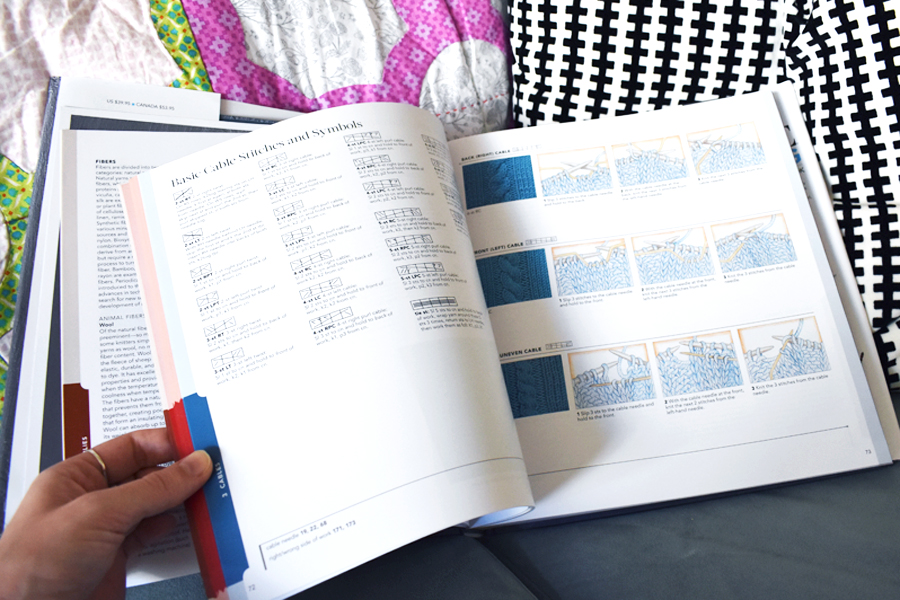
When Sterling Publishing asked me if I’d like a free copy of the latest edition of Vogue Knitting: The Ultimate Knitting Book for review, my answer was immediately, “Yes.” I think there are three essential types of books that every knitter should have in their library, and a good reference book is number one on that list, but I didn’t have a recommendation that was helpful for knitters who need visuals as wells as written instructions. I was hoping Vogue Knitting: The Ultimate Knitting Book would fill that gap, and spoiler: it does!
This large, coffee-table sized book provides overviews on everything from basic to advanced. There’s a section on tools, with each named and photographed so you won’t feel clueless when shopping at your LYS. Basic techniques like working in the round, cabling, blocking finished knits, and more are covered. There are instructions for a variety of techniques, including dozens of CO- and BO-methods. Hand-drawn illustrations show how to work each technique, and clear photographs show how the final product will look. There isn’t a high level of detail explaining where to use each technique and their strengths and weaknesses, but I’m a firm believer in experimenting with swatches to form your own opinion, and the book provides enough information to know which selection of techniques to test to find the right one for your project. Plus, because this is a newer book, the names of the techniques are the ones that are most commonly used currently, so it’s easy to look them up online to learn even more. The book also has a section on advanced techniques, where you can find instructions on increasing and decreasing in brioche stitch or working lace while double knitting.

After covering tools and the technical side of knitting, the book gets into reading patterns, which is its weakest section, in my opinion. It gives an overview on how sizes and schematics work, and the explanation on gauge and swatching is very well done. But when it comes to terminology, abbreviations, and charts, this book isn’t a very strong resource except for Vogue Knitting patterns. The list of abbreviations doesn’t include alternative abbreviations and is simply a better-explained version of the list you’d find in the back of an issue of Vogue Knitting. For example, “yarn forward” is listed as “YF,” and the other common abbreviation, “YFWD” isn’t mentioned anywhere. Likewise, the list of common terminology doesn’t include language that isn’t used in Vogue Knitting patterns, and the cable chart symbols might look strange to you if you’ve only worked with patterns that use the Craft Yarn Council standards. The book calls chart symbols “universal,” but doesn’t acknowledge that there isn’t only one standard for their appearance so a chart key should always be referenced. This section isn’t as thorough as I’d like it to be, but because abbreviations and chart symbols should be defined in whatever pattern you’re working with, it doesn’t spoil the book for me that this chapter doesn’t cover a wider range of pattern writing styles. It’s just a minor disappointment.
The next handful of sections are about construction. There’s a meaty chapter on sweater construction that includes information on how to knit a variety of styles– raglan, set-in sleeve, circular yoke, etc.– and it has a breakdown on common neckline treatments, buttonhole techniques, pockets, and more. The chapter on sweater construction is one of the longest in the book, and it covers a lot! It doesn’t offer a beginner-friendly level of detail on calculating your own sweater, but it’s a wonderful resource for understanding how exactly the construction works, and it looks useful for more experienced knitters who simply need a short explanation and a list of what to calculate. After sweaters comes a whole chapter on constructing shawls, and then there’s one on accessories. The accessory chapter covers a wide range of projects, from head to toe, and there’s a number of measurement tables, which seems incredibly useful for designers and gift-knitters. There are tables on average hand and feet measurements, which include measurements that can be hard to find online.
Overall, this is a good book to have in your knitting library, particularly if you don’t yet have a reference book. I normally wouldn’t sit down and try to read through a reference book outside of reviewing one, but Vogue Knitting: The Ultimate Knitting Book presents its content in such an attractive manner, that it’s enjoyable to flip through and learn something new. It’s not always as thorough as I’d like, but a single book can’t possibly cover everything, and the illustrations and wide range of information inside have a lot to offer. If you’re looking for a reference book that uses modern terminology, covers a little bit of everything, and includes illustrations, this is a nice one to own.
Leave a Reply